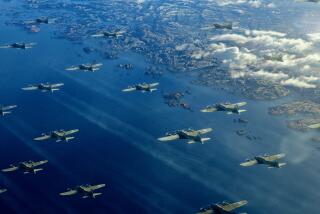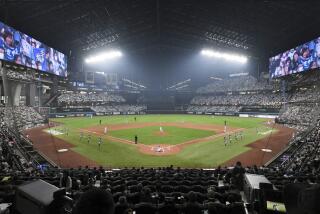Heâs an Ace at Solving WWII Air Combat Puzzles
Even after 43 years, an American World War II fighter pilot kept wondering about the Japanese plane he had shot down near Shanghai in 1945--the one that flipped on its nose but did not burn.
Now the former pilot from Pennsylvania thinks he knows, thanks to Henry Sakaida of Temple City.
Sakaida believes that he has learned the identity of the Japanese pilot.
âThe guy lived!â Sakaida said when he finally put a big missing piece into his unique kind of puzzle.
Sakaida, who makes a hobby of pairing former combatants in the dogfights of World War II, is eagerly awaiting final confirmation that the two men did indeed try to kill each other on that fateful January day.
Sakaida said he was delighted to take on the seemingly impossible task of tracking down the enemy pilot that Edward Bollen of Sewickley, Pa., remembers shooting down. He did so simply because Bollen, whom he has never met, was curious about his long-ago foe.
Sakaida believes the man is Eiji Mitsui of Urawa, Japan, a one-time flying ace who not only cannot remember the date he was shot down but who has also changed his surname.
âMost Unusual Hobbyâ
Admitting to âa most unusual hobby,â Sakaida, a Rosemead nurseryman, has been able to identify dozens of World War II combat pilots who played their deadly game in the skies over Asia and the Pacific.
In many cases, the opponents were killed in combat or have since died.
But some of those who survived now see themselves as comrades with common bonds. Like others Sakaida has linked, Bollen said he hopes that he and Mitsui will someday meet and exchange friendly greetings.
This case was particularly knotty for Sakaida, since in his flight report on Jan. 14, 1945, Bollen misidentified the type of plane he downed at Hankow Airfield. Most Japanese military records were destroyed after the war, Sakaida said.
But both former pilots recall exactly the same experience at about the same time, when the Japanese plane, after it was strafed by Bollen, flipped over into some grass in an emergency landing attempt.
Sakaida worked on this puzzle for a month, putting pieces together through World War II flight reports he obtained from government archives and through friends in Japan who share his interest in history and fighter pilots.
In many other cases, he said, his research and investigation continued for years before he was able to establish combatantsâ identities.
âNeat Guyâ
âThat Henry is something else,â Bollen said from his home in Pennsylvania. âIâm personally interested in people Iâve fought against, but I never realized I would have the opportunity Henry Sakaida has given me. When he located Mr. Mitsui, he was so excited he called me in the middle of the day and again that evening. Henry seems like a real neat guy.â
Sakaida, 38, was born in California long after World War II ended and has no personal connection with that period, nor is he a flier. During the war, his father, John, was assigned to Manzanar, a relocation camp for Japanese-Americans. His mother, Tokie, grew up in Japan. The family owns the Sakaida Nursery in Rosemead.
A graduate of Rosemead High School and San Jose State, Sakaida lives in Temple City with his wife, Donna, and their two young sons. One room in their home is devoted to World War II memorabilia, including shelves of books that fellow history buffs have written and sent him. Sakaida, in turn, has sent them copies of his 1983 book, âWinged Samurai,â which tells the story of Saburo Sakai, a Japanese flying ace.
Sakaida said his interest in contacting enemy pilots began in 1975 on a vacation in Japan. A former fighter pilot asked Sakaida to help him identify the American who had shot him down over Guam in 1944.
âAfter checking around, I found it wouldnât be that difficult,â Sakaida said.
Although he was unable to identify the American pilot, he found himself hooked on a hobby that promised great personal satisfaction.
Several years ago, he wrote a newsletter about fighter pilots. Since then, most requests for information and research come to him by word of mouth, mostly from former pilots who keep in touch with each other.
âThe reward is the smile on peopleâs faces, you know?â he said. âIf I got money out of it, that would just kind of ruin it. Itâs just fun seeing these people so happy, especially the ones that meet and shake hands.â
In 1983, Sakaida arranged a meeting at his parentsâ home between Sakai and an American adversary, Harold Jones, who battled in 1942 in the skies above Guadalcanal.
Sakaida has discovered that the fighter pilots he has researched have distinct traits, among them a total lack of animosity for their opponents.
âThey were technicians--super-soldiers,â Sakaida said. âSo much training went into being a pilot; that was a common bond. They liked to fly, the thrill of combat, and now they like to relive the excitement.
âIt was a life-and-death game. . . . They were kind of above it all. Iâve never had any problem with hatred--no animosity on either side. They all say war was a tragedy, they just had to do their jobs. Nothing personal.â
Bollen said: âThis was not like the infantry, where youâre surrounded by dead bodies. Of course, during the war you have a hate on for the enemy because theyâre shooting your buddies. But they werenât necessarily wanting to kill any more than we were.
âAnd after the war, you wonder what it was all about, and wish you knew about the ones who were still living. So then you want to meet and shake hands.â
Sakaidaâs explanation for spending so much time matching up enemies who do not know each other--most of whom he has never met and never will--is: âItâs just fun. I like history, and I like to solve mysteries. Itâs fascinating trying to track these people down.â
Sakaida once worked off and on for four years to identify a New Zealand flier who parachuted from his plane and was rescued by Sakaidaâs friend and neighbor, Minoru Fujita of Rosemead, who commanded a Japanese navy gunboat in 1945.
Fujita had been haunted by the memory of the injured pilot, who had asked Fujita to pray with him. After saying the Lordâs Prayer together, the pilot was taken to a hospital. In 1987, with Sakaidaâs help, Fujita learned that the New Zealander had died two weeks later.
So important was this information to Fujita that he located the pilotâs grave in New Caledonia, where he prayed for him again. He also met the victimâs brother in New Zealand.
More to Read
Sign up for Essential California
The most important California stories and recommendations in your inbox every morning.
You may occasionally receive promotional content from the Los Angeles Times.










